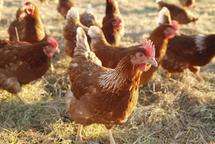Scientists explain why birds get sex on the brain in the Spring

(PhysOrg.com) -- Oxford University researchers have discovered how birds sense the lengthening days of early Spring and time when they breed, solving a 70-year mystery.
Light receptors deep in the brains of birds detect the changing day length and trigger the seasonal development of the reproductive system. If all goes well chicks hatch six to eight weeks later.
The research, published in the journal Current Biology and funded by the Wellcome Trust and the Biotechnology and Biological Sciences Research Council, has pinpointed the identity of the light receptors in chicken and Japanese quail in a deep part of the brain called the hypothalamus.
‘When you hear birds singing in the Springtime, it’s a light-sensitive molecule deep in their brain that’s triggered this reproductive event,’ says Professor Russell Foster of the Nuffield Laboratory of Ophthalmology at the University of Oxford, who led the work. ‘By timing their mating to the changing seasons, birds can make sure that there will be enough food around for their chicks.
'For example, rooks eat worms, and they have their offspring early in Spring when the soil is still moist and the worms are at the surface. Finches will have their chicks later in the year to match when there are seeds around to feed them.’
Exactly how birds sense the arrival of Spring has been a long-standing problem. In the 1930s, it was shown that birds surprisingly don’t use their eyes to measure the increasing number of hours of sunlight. Instead a deep part of their brain registers day length. This is possible because bird skulls and brain tissue let a lot of light through so that a significant amount of light still reaches deep parts of the brain.
'Eyes can respond very well to light in fractions of a second, which is crucial for vision. But detecting dawn and dusk requires measuring changing levels of light over long periods of time, a different thing altogether. This is what the light receptors do in a deep part of the bird’s brain called the hypothalamus,’ says Professor Foster.
Since the initial research in the 1930s, a whole cascade of events have been identified that lead to the production of hormones which stimulate the reproductive response in birds. But the identity of the initial deep-brain light sensors have remained a mystery. It has remained one of Professor Foster’s research interests for 25 years since he started his PhD.
In this new work, Professor Foster and colleagues identified a gene in the chicken genome that encodes a novel light-sensitive molecule. The molecule belongs to a family of photopigments called VA opsins that were first discovered in fish. These light-sensitive molecules are not involved in vision but detect slow changes in the light environment such as dawn and dusk.
The team showed in lab tests that when this chicken gene is active in nerve cells, the nerve cells generate electric signals in response to light. Finally, they demonstrated that chicken VA opsin is present in the hypothalamus.
‘We have shown that chickens have a pigment called VA opsin, that it reacts to light, and that it is around in exactly the part of the bird’s brain that we know responds to day length,’ says Dr Stephanie Halford, first author on the study. ‘This evidence is as strong as we can get that we’ve pinpointed the light receptors that tune birds’ responses to the changing seasons.’
Provided by Oxford University (news : web)













